engine Lancia Delta 2015 Owner handbook (in English)
[x] Cancel search | Manufacturer: LANCIA, Model Year: 2015, Model line: Delta, Model: Lancia Delta 2015Pages: 291, PDF Size: 6.74 MB
Page 229 of 291
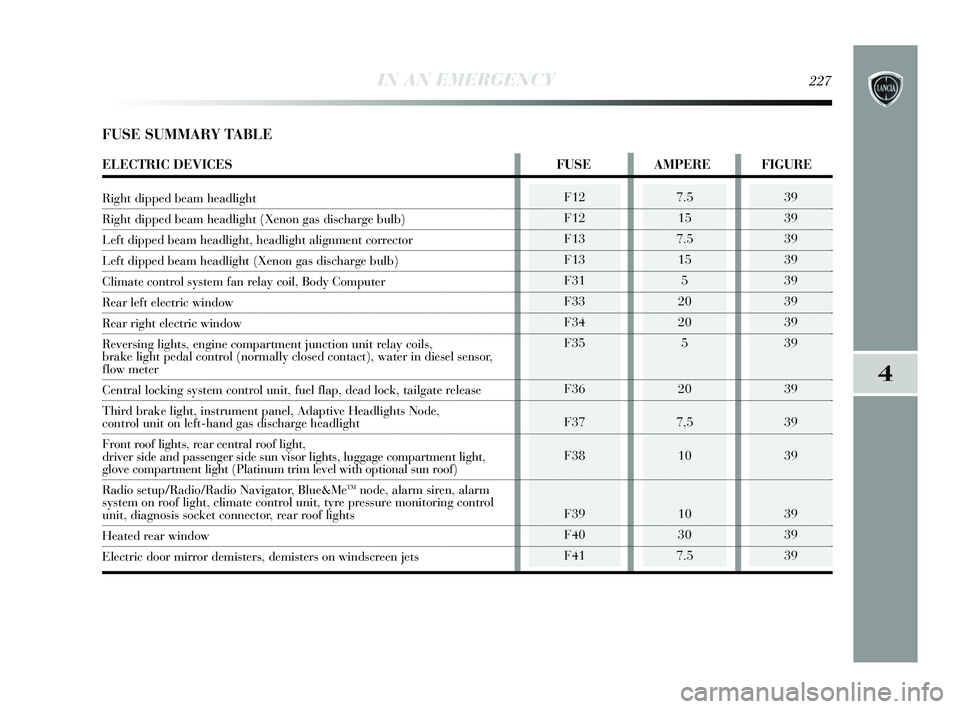
IN AN EMERGENCY227
4
F12
F12
F13
F13
F31
F33
F34
F35
F36
F37
F38
F39
F40
F417.515
7.5 15 5
20
20 5
20
7,5 10
10
30
7.539
39
39
39
39
39
39
39
39
39
39
39
39
39
FUSE SUMMARY TABLE
ELECTRIC DEVICES FUSE AMPERE FIGURE
Right dipped beam headlight
Right dipped beam headlight (Xenon gas discharge bulb)
Left dipped beam headlight, headlight alignment corrector
Left dipped beam headlight (Xenon gas discharge bulb)
Climate control system fan relay coil, Body Computer
Rear left electric window
Rear right electric window
Reversing lights, engine compartment junction unit relay coils,
brake light pedal control (normally closed contact), water in diesel sensor,
flow meter
Central locking system control unit, fuel flap, dead lock, tailgate release
Third brake light, instrument panel, Adaptive Headlights Node,
control unit on left-hand gas discharge headlight
Front roof lights, rear central roof light,
driver side and passenger side sun visor lights, luggage compartment lig\
ht,
glove compartment light (Platinum trim level with optional sun roof)
Radio setup/Radio/Radio Navigator, Blue&Me
TMnode, alarm siren, alarm
system on roof light, climate control unit, tyre pressure monitoring control
unit, diagnosis socket connector, rear roof lights
Heated rear window
Electric door mirror demisters, demisters on windscreen jets
195-232 Delta GB 1ed 03/03/14 09.15 Pagina 227
Page 234 of 291

232IN AN EMERGENCY
When towing, remember that without the help
of the brake servo and electric power steer-
ing, a greater effort is required on the pedal
and steering wheel. Do not use flexible cables when
towing and avoid jerky movements. During towing,
make sure that the trailer hitch does not damage any
components it is touching. When towing the car, it
is compulsory to respect specific highway code reg-
ulations relating to the tow hook and procedures for
towing on the road. Do not start the engine while
towing the car. Before tightening the ring clean the
threaded housing thoroughly. Make sure that the
ring is securely fastened before towing the car.
The front and rear tow hooks must only be
used for emergency situations on the road.
The car may be towed for short distances
when a dedicated device is used in compliance with
the Highway Code (rigid bar), and in order to move
the vehicle on the road in preparation for towing
or transport via a breakdown vehicle. Tow hooks
MUST NOT be used to tow vehicles off the road or
where there are obstacles and/or for towing oper-
ations using cables or other non-rigid devices. Re-
specting the above conditions, towing must take
place with two vehicles (one towing, the other towed)
aligned as much as possible along the same centre
line.Before towing, turn the ignition key to MAR
and then to STOP without removing it. The
steering column will automatically lock when
the key is removed and the wheels cannot be steered.
195-232 Delta GB 1ed 03/03/14 09.15 Pagina 232
Page 237 of 291
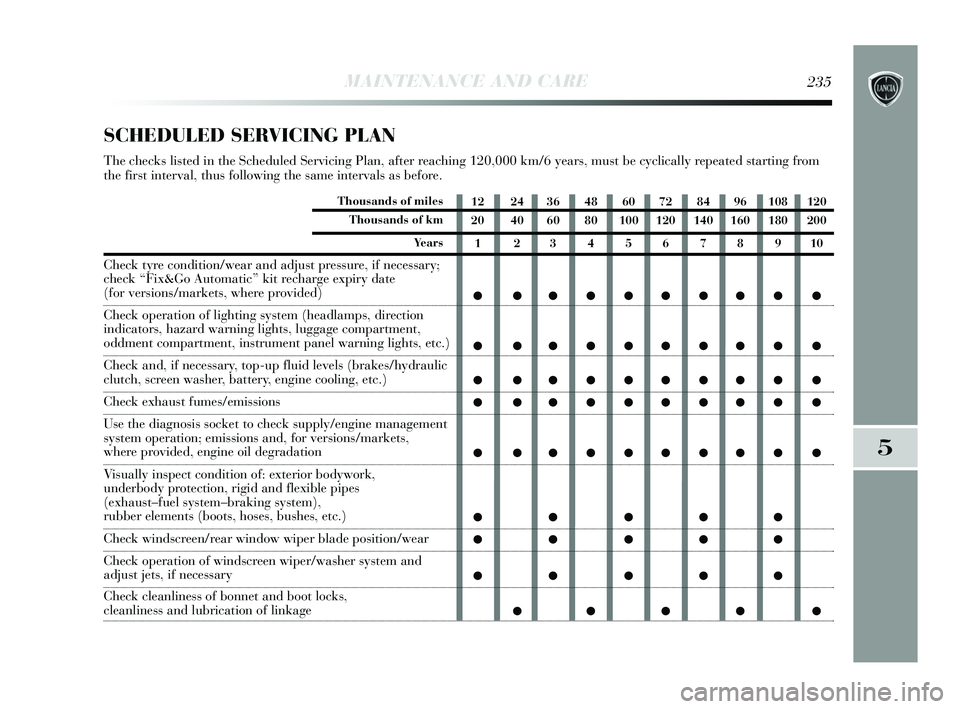
MAINTENANCE AND CARE235
5
12 24 36 48 60 72 84 96 108 120
20 40 60 80 100 120 140 160 180 2001 2345678910
● ●●●●●●●● ●
● ●●●●●●●● ●
● ●●●●●●●● ●
● ●●●●●●●● ●
● ●●●●●●●● ●
● ● ●●●
● ● ●●●
● ● ●●● ●●●● ●
SCHEDULED SERVICING PLAN
The checks listed in the Scheduled Servicing Plan, after reaching 120,000 km/6 years, must be cyclically repeated starting from
the first interval, thus following the same intervals as before.
Thousands of miles
Thousands of km
Years
Check tyre condition/wear and adjust pressure, if necessary;
check “Fix&Go Automatic” kit recharge expiry date
(for versions/markets, where provided)
Check operation of lighting system (headlamps, direction
indicators, hazard warning lights, luggage compartment,
oddment compartment, instrument panel warning lights, etc.)
Check and, if necessary, top-up fluid levels (brakes/hydraulic
clutch, screen washer, battery, engine cooling, etc.)
Check exhaust fumes/emissions
Use the diagnosis socket to check supply/engine management
system operation; emissions and, for versions/markets,
where provided, engine oil degradation
Visually inspect condition of: exterior bodywork,
underbody protection, rigid and flexible pipes
(exhaust–fuel system–braking system),
rubber elements (boots, hoses, bushes, etc.)
Check windscreen/rear window wiper blade position/wear
Check operation of windscreen wiper/washer system and
adjust jets, if necessary
Check cleanliness of bonnet and boot locks,
cleanliness and lubrication of linkage
233-256 Delta GB 1ed 03/04/14 13:27 Pagina 235
Page 238 of 291
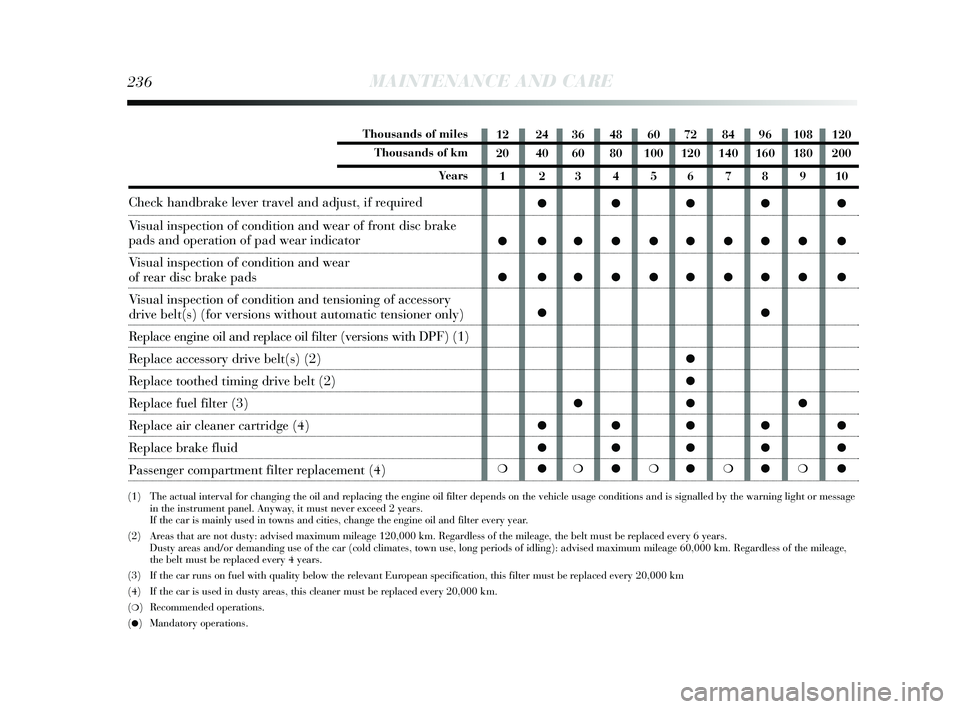
236MAINTENANCE AND CARE
12 24 36 48 60 72 84 96 108 120
20 40 60 80 100 120 140 160 180 2001 2345678910
●●●● ●
● ●●●●●●●● ●
● ●●●●●●●● ● ●●
●
●
●●●
●●●● ●
●●●● ●
❍ ●❍●❍●❍●❍ ●
(1) The actual interval for changing the oil and replacing the engine oil filter depends on the vehicle usage conditions a\
nd is signalled by the warning light or message
in the instrument panel. Anyway, it must never exceed 2 years.
If the car is mainly used in towns and cities, change the engine oil and\
filter every year.
(2) Areas that are not dusty: advised maximum mileage 120,000 km. Regardless of the mileage, the belt must be replaced every 6 y ears.
Dusty areas and/or demanding use of the car (cold climates, town use, long peri\
ods of idling): advised maximum mileage 60,000 k m. Regardless of the mileage,
the belt must be replaced every 4 years.
(3) If the car runs on fuel with quality below the relevant European specification, this filter must be replaced every 20,000 km
(4) If the car is used in dusty areas, this cleaner must be replaced every 20,000 km.
(
❍) Recommended operations.
(
●) Mandatory operations.
Thousands of miles
Thousands of km
Years
Check handbrake lever travel and adjust, if required
Visual inspection of condition and wear of front disc brake
pads and operation of pad wear indicator
Visual inspection of condition and wear
of rear disc brake pads
Visual inspection of condition and tensioning of accessory
drive belt(s) (for versions without automatic tensioner only)
Replace engine oil and replace oil filter (versions with DPF) (1)
Replace accessory drive belt(s) (2)
Replace toothed timing drive belt (2)
Replace fuel filter (3)
Replace air cleaner cartridge (4)
Replace brake fluid
Passenger compartment filter replacement (4)
233-256 Delta GB 1ed 03/04/14 13:27 Pagina 236
Page 239 of 291

PERIODIC CHECKS
Every 1,000 km or before long journeys, check and, if nec-
essary, top up the following:
❍engine coolant fluid level;
❍ brake fluid level;
❍ windscreen washer fluid level;
❍ tyre pressure and condition;
❍ operation of lighting system (headlights, direction in-
dicators, hazard warning lights, etc.);
❍ operation of the windscreen/rear window wiper/wash-
er system, position and wear of windscreen/rear win-
dow wiper blades;
Every 3,000 km check and top up if required: engine oil
level.
DEMANDING USE OF THE CAR
Should the prevailing use of the car be under one of the
following specially demanding conditions:
❍ trailer or caravan towing;
❍ dusty roads;
❍ short (less than 7-8 km) and repeated journeys in sub-
zero temperatures;
❍ engine often idling or driving long distances at low
speeds or prolonged inactivity;
MAINTENANCE AND CARE237
233-256 Delta GB 1ed 03/04/14 13:27 Pagina 237
Page 240 of 291
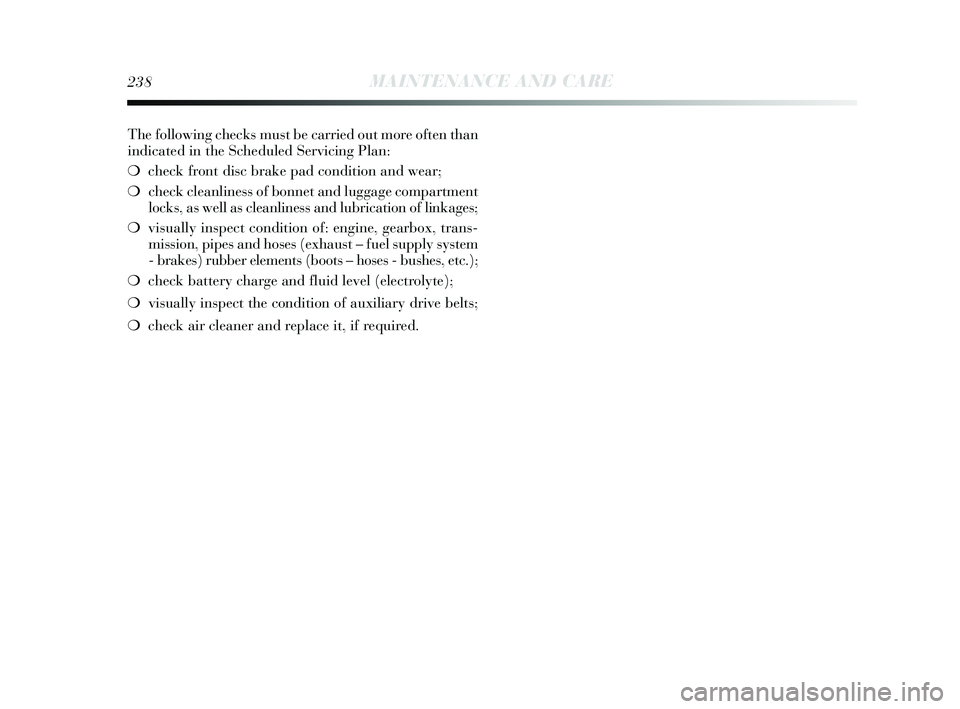
The following checks must be carried out more often than
indicated in the Scheduled Servicing Plan:
❍check front disc brake pad condition and wear;
❍ check cleanliness of bonnet and luggage compartment
locks, as well as cleanliness and lubrication of linkages;
❍ visually inspect condition of: engine, gearbox, trans-
mission, pipes and hoses (exhaust – fuel supply system
- brakes) rubber elements (boots – hoses - bushes, etc.);
❍ check battery charge and fluid level (electrolyte);
❍ visually inspect the condition of auxiliary drive belts;
❍ check air cleaner and replace it, if required.
238MAINTENANCE AND CARE
233-256 Delta GB 1ed 03/04/14 13:27 Pagina 238
Page 242 of 291

ENGINE OIL A - Fig. 1
Check the oil level a few minutes (about five) after the en-
gine has stopped, with the car parked on level ground. The
oil level should be between the MIN and MAX marks on
the dipstick. The range between the MIN and MAX marks
corresponds to about 1 litre of oil.
If the level of the oil is close to or below the MIN mark,
add oil via the filler neck until the MAX mark is reached.
The oil level must never exceed the MAX mark.
Engine oil consumption
The maximum engine oil consumption is usually 400
grams every 1,000 km. When the car is new, the engine
needs to run in, therefore the engine oil consumption can
only be considered stabilised after the first 5,000 - 6,000
km.
IMPORTANT The oil consumption depends on driving
style and car usage conditions.
IMPORTANT After adding or changing the oil, let the en-
gine run for a few seconds and wait a few minutes after
turning it off before you check the level.When the engine is hot, take care when work-
ing inside the engine compartment to avoid
burns. Remember that when the engine is hot,
the fan may operate: danger of injury. Pay atten-
tion to scarves, ties and other loose fitting garments:
they may get caught by moving components.
Do not add any oil with different specifica-
tions than those of the existing engine oil.
The used engine oil and the replaced oil fil-
ter contain substances that may be danger-
ous for the environment. It is advisable to
have oil and filters changed by a Lancia Dealership
where they will be disposed of according to the law.
240MAINTENANCE AND CARE
233-256 Delta GB 1ed 03/04/14 13:27 Pagina 240
Page 243 of 291

ENGINE COOLANT B - Fig. 1
The coolant level must be checked when the engine is cold
and must range between the MIN and MAX marks on the
reservoir. If the level is low, slowly pour a mixture of 50%
demineralised water and 50% PARAFLU
UPof
PETRONAS LUBRICANTS through the filler neck until
the level reaches MAX.
The mixture of 50% PARAFLU
UPand 50% distilled wa-
ter protects against freezing down to temperatures of
–35°C. For particularly harsh climate conditions, we rec-
ommend using a mixture of 60% PARAFLU
UPand 40%
distilled water.
PA R A F L UUPanti-freeze is used in the engine
cooling system. Use the same fluid as in the
cooling system when topping up. PARAFLU-
UPcannot be mixed with any other type of fluid. If
this occurs, do not start the engine and contact your
Lancia Dealership immediately.
The cooling system is pressurised. If nec-
essary, only replace the plug with another
original one or the operation of the system
may be adversely affected. Do not remove the cap
from the reservoir when the engine is hot: danger
of scalding.
MAINTENANCE AND CARE241
233-256 Delta GB 1ed 03/04/14 13:27 Pagina 241
Page 244 of 291
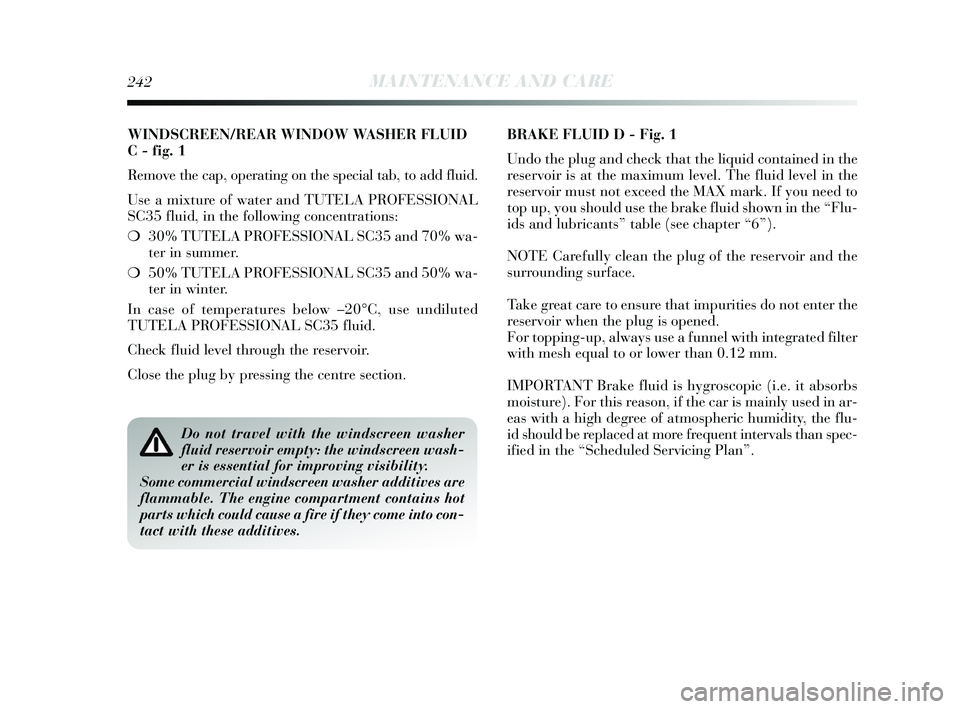
WINDSCREEN/REAR WINDOW WASHER FLUID
C - fig. 1
Remove the cap, operating on the special tab, to add fluid.
Use a mixture of water and TUTELA PROFESSIONAL
SC35 fluid, in the following concentrations:
❍30% TUTELA PROFESSIONAL SC35 and 70% wa-
ter in summer.
❍ 50% TUTELA PROFESSIONAL SC35 and 50% wa-
ter in winter.
In case of temperatures below –20°C, use undiluted
TUTELA PROFESSIONAL SC35 fluid.
Check fluid level through the reservoir.
Close the plug by pressing the centre section.
Do not travel with the windscreen washer
fluid reservoir empty: the windscreen wash-
er is essential for improving visibility.
Some commercial windscreen washer additives are
flammable. The engine compartment contains hot
parts which could cause a fire if they come into con-
tact with these additives.
BRAKE FLUID D - Fig. 1
Undo the plug and check that the liquid contained in the
reservoir is at the maximum level. The fluid level in the
reservoir must not exceed the MAX mark. If you need to
top up, you should use the brake fluid shown in the “Flu-
ids and lubricants” table (see chapter “6”).
NOTE Carefully clean the plug of the reservoir and the
surrounding surface.
Take great care to ensure that impurities do not enter the
reservoir when the plug is opened.
For topping-up, always use a funnel with integrated filter
with mesh equal to or lower than 0.12 mm.
IMPORTANT Brake fluid is hygroscopic (i.e. it absorbs
moisture). For this reason, if the car is mainly used in ar-
eas with a high degree of atmospheric humidity, the flu-
id should be replaced at more frequent intervals than spec-
ified in the “Scheduled Servicing Plan”.
242MAINTENANCE AND CARE
233-256 Delta GB 1ed 03/04/14 13:27 Pagina 242
Page 248 of 291

246MAINTENANCE AND CARE
USEFUL ADVICE FOR EXTENDING THE LIFE OF
YOUR BATTERY
To avoid draining your battery and make it last longer,
observe the following instructions:
❍when you park the car, ensure the doors, tailgate and
bonnet are closed properly, to prevent any light from
remaining on inside the passenger compartment;
❍ turn off the internal roof lights, although the car does
have an automatic system for switching off internal
lights;
❍ do not leave devices (e.g. car radio, hazard warning
lights, etc.) switched on for a long time when the en-
gine is not running;
❍ before performing any operation on the electrical sys-
tem, disconnect the negative battery cable;
❍ battery terminals should always be perfectly tightened.
IMPORTANT If the charge level remains under 50% for
a long time, the battery is damaged by sulphation, re-
ducing its capacity and efficiency at start-up. The battery will also be more at risk of freezing (this can
happen as early as –10°C). In case of prolonged idling, re-
fer to the “Car inactivity” paragraph, in chapter “3”.
If, after purchasing your car, you decide to install electri-
cal accessories which require a permanent electric power
supply (alarm, etc.) or accessories which have a serious
impact on the electrical balance, contact a Lancia Deal-
ership: their qualified personnel will suggest the most suit-
able Lancia Lineaccessori devices and assess the overall
electric consumption, checking whether the car’s electri-
cal system can cope or whether a more powerful battery
is required.
Since some of these devices continue to consume electric-
ity even when the engine is off, they gradually run down
the battery.
233-256 Delta GB 1ed 03/04/14 13:28 Pagina 246